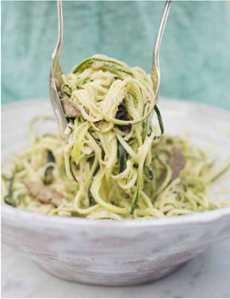TIP OF THE DAY: Mix Zucchini Ribbons With Pasta
|
When we were 10 years old, Mom planted zucchini in the backyard. We watched in awe as they multiplied faster than the brooms in the Sorcerer’s Apprentice scene from Fantasia. It wasn’t a big plot—maybe 6’ x 8’—but it produced so much zucchini, we couldn’t eat half of it, and gave the rest away. A pre-tip tip: Pick or buy zucchini on the smaller side. As they get bigger, they get more watery and bland. We left a few on the vine until the end of the season. There’s a photo of us with our brother, holding up one that grew to three feet long and very wide in girth. Impressive, but not very tasty. (According to Guinness World Records, the longest zucchini measured 7 ft 10.3 inches, harvested in October 2005 in a home garden in Brampton, Ontario, Canada.) > The recipe is below, but first: That summer Mom made: It can be served hot or cold, or used as a topping for bruschetta or crostini. Serving it chilled or at room temperature, topped with Greek yogurt and a chiffonade of fresh basil, is a delicious first course with toasts or crackers, Or, use it to top salad fixings, and garnished with black olives. |
 [1] Regular pasta ribbons mixed with zucchini ribbons, to create a fun dish that really cuts down on calories (photo © Vegetarian Everyday Cookbook).
|
|
|
August 8th, National Zucchini Day, is a good day for zucchini in any form. Last year, we made zucchini “pasta” with the Microplane Spiral Cutter, a gadget that peels whole zucchini into pasta-like strands (it does the same with cucumbers, carrots and other root vegetables). You can use a box grater, but for less than $15, this gadget makes it easy. Since then, we’ve been playing with other ways to use zucchini pasta, including swirling the uncooked ribbons into a bird’s nest shape, filled with deviled eggs, egg salad, scrambled eggs and, beyond the nest-and-eggs theme, with marinated cherry tomatoes and other salad ingredients. But today, we share this idea sent to us from Good Eggs [a supplier of the exceptional produce and specialty foods], excerpted from The Beetlebung Farm Cookbook: A Year of Cooking on Martha’s Vineyard. The recipe combines conventional ribbon pasta (long strands, like spaghetti and fettuccine) with zucchini ribbons, and makes the pasta dish more nutritious. Zucchini contains lots of vitamin C, plus B6, magnesium, iron, and calcium. But more important to most people, cooked zucchini has just 20 calories per cup, compared with 182 calories for pasta (174 calories for whole wheat pasta). Do the math—and use whole wheat pasta instead of refined white flour pasta for lots more fiber. A trick for reducing the calories of pasta by half: mix them with zucchini noodles. The combination amps up the flavor and eye appeal. Crab adds a touch of elegance to this pasta dish, but you can use any seafood (clams, mussels, oysters, shrimp, etc.) or make a vegetarian version. Ingredients *Barilla makes both of these round ribbon pasta shapes. However, since the zucchini ribbons are flat, we went with fettuccine, a flat ribbon pasta (linguine is a thinner version). |
||
|
|
Preparation 1. BRING a large pot of salted water to a boil. 2. COMBINE in a small bowl the crab, jalapeño and 1 tablespoon of olive oil. Chop half of the mint and mix gently with the crab. 3. PUT the remaining mint in a second bowl. Grate the squash using a large-hold grater, stopping short of the seedy cores. Add the squash to the mint along with vinegar, garlic, remaining olive oil, salt and pepper. Mix and set aside. 4. COOK the pasta until al dente, about 7 minutes. Meanwhile, heat a large skillet over medium-high heat. Add the marinated crab, marinated squash and basil and heat through. 5. DRAIN the pasta, reserving some pasta water. Add the pasta to the crab mixture along with some reserved pasta water (enough to loosen the sauce). Heat, tossing to mix well. Season with salt, pepper, and lemon juice. |
|
|
| ||
ZUCCHINI HISTORY
A botanical fruit†, zucchini is treated as a vegetable, and used as a savory dish or accompaniment (with the exception of zucchini bread and muffins).
All squash originated in Central and South America and was eaten for thousands of years before Europeans discovered it in the 16th century. It grew in different shapes, including round zucchini balls that you can grow from heirloom seeds.
Christopher Columbus originally brought seeds to the Mediterranean region and Africa. However, the long, green zucchini that have become the standard was developed at the end of the 19th century near Milan, Italy.
Zucchini, Cucurbita pepo, is a member of the cucumber and melon family, Cucurbitaceae. The word squash comes from the Narraganset language of the Native Americans of Rhode Island, who grew askutasquash, “a green thing eaten raw.” The Pilgrims had difficulty pronouncing the whole word and shortened it to squash. It was an important food crop for both peoples.
The word zucchini comes from the Italian zucchino, meaning a small squash (zucca is the word for pumpkin).
A word about squash blossoms: A long orange blossom grows on the end of each emerging zucchini. It is considered a delicacy, and can be stuffed and fried or pan-fried plain. Alas, this treat was not widely known in our youth, and Mom simply tossed them out.
__________________
†All squash are botanical fruits. Zucchini is the swollen ovary of the zucchini flower. Here’s the difference between fruits and vegetables.

